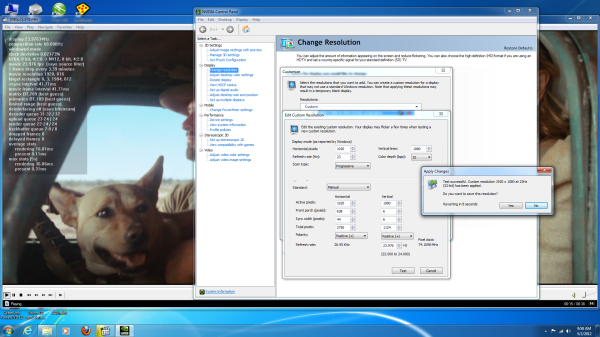ASRock's High-End Vision 3D 252B HTPC Review
by Ganesh T S on May 7, 2012 6:15 AM EST- Posted in
- Home Theater
- Sandy Bridge
- HTPC
- GT 540M
- NVIDIA
One of the issues with the ASRock CoreHT 252B was the fact that the integrated Intel HD Graphics 3000 was unable to refresh the display at 23.976 Hz even when configured manually. AMD GPUs have had a history of being close to the desired refresh rates out of the box, while NVIDIA GPUs end up needing some tweaking. This is further compounded by the fact that different setups behave differently even with the same card. How does the GT 540M in the Vision 3D 252B fare?
As we have recounted in earlier HTPC reviews, a GPU should ideally be capable of the following refresh rates at the minimum:
- 23.976 Hz
- 24 Hz
- 25 Hz
- 29.97 Hz
- 30 Hz
- 50 Hz
- 59.94 Hz
- 60 Hz
Some users demand integral multiples of 23.976 / 24 Hz because they result in a smoother desktop experience, while also making sure that the source and display refresh rates are still matched without repeated or dropped frames. The gallery below shows the refresh rate handling for 24, 25 (x2 = 50 Hz), 29.97 (x2 = 59.94 Hz), 30 (x2 = 60 Hz), 50, 59.94 and 60 Hz settings.
The native 23 Hz setting, unfortunately, resulted in a 23.971 Hz refresh rate.
However, with some custom timing setup, we were able to achieve 23.97634 Hz.
The custom timing feature is usable, but not without its quirks. Adding a custom resolution is straightforward. Setting the vertical parameters to values similar to the ones in the screenshot above achieves desired results, but the 23 Hz resolution gets saved as 24 Hz. The pictures in the gallery below bring out the issue. The first picture shows that the 23 Hz setting gets saved as 24 Hz in the NVIDIA control panel. The second picture shows that the 24 Hz setting is no longer available in the set of native refresh rates. The third picture shows that all the available EDID resolutions are displayed in the monitor properties. The fourth screenshot shows that setting the 23 Hz option in the monitor properties puts the control panel in 24 Hz custom mode (with the screen refreshing at 23.97637 Hz). The fifth screenshot shows the effect of setting the 24 Hz option in the monitor properties. Note that the control panel still shows the custom 24 Hz setting. In the sixth screenshot, we selected the 23 Hz setting of the NVIDIA control panel (under native resolution - the one that we actually intended to replace in the first place) only to get the display refreshing at 23.971 Hz. The final picture shows the NVIDIA control panel set to custom 24 Hz resulting in a display refresh rate closer to the intended 23.976 Hz.
We hope NVIDIA fixes this annoying issue in one of the upcoming driver releases.























60 Comments
View All Comments
jabber - Monday, May 7, 2012 - link
I bought about a dozen of the first generation Atom boxes and they are all still trucking and the customers still love them.I still want one for myself.
TerdFerguson - Monday, May 7, 2012 - link
For what they were meant for, the little ION machines were flipping fantastic. With a package price of below $200 for everything but the OS, it's a value proposition that hasn't been matched by anything since.duploxxx - Monday, May 7, 2012 - link
yes there are but not all OEM have the guts to do it right and just stuff garbage onto consumers. If they love it means they have never used anything else...http://www.anandtech.com/show/4442/zotac-zbox-braz...
BPB - Monday, May 7, 2012 - link
Am I the only guy who goes to the bottom of the specs sheet first and looks fir price? This thing is way too much for an HTPC.duploxxx - Monday, May 7, 2012 - link
what would you expect if you see following specs...Intel Sandy Bridge Core i5-2520M
(2 x 3.00 GHz (3.20 GHz Turbo), 32nm, 3MB L2, 35W)
Graphics NVIDIA GT 540M (1 GB VRAM)
1 reason why you would need these 2 parts into a HTPC, can be replaced by 1 APU which cost less and consumes less in total, end of story.
BPB - Monday, May 7, 2012 - link
I am not saying it isn't worth it. I am saying I see HTPC in the review title, look at the price, and think it's not worth reading the article. Simply can't see spending that on an HTPC, that's all. It is not a knock on the product. I'd be very happy owning this.cknobman - Monday, May 7, 2012 - link
Agreed.Over $1000 for a HTPC and then with these specs to boot?
Im not saying the specs are bad but they are certainly not worth of over $1000.
mbzastava - Monday, May 7, 2012 - link
I recall reading a nice comment from the Intel NUC article which points out how this new form factor is just repackaged laptop parts whith a nice new profit margin. I couldn't agree with him more.The question you should be asking is: Why does this unit cost around $1000 when you could get a similarly specced laptop for almost $300 less?
ganeshts - Monday, May 7, 2012 - link
Economy of scale - How many such HTPCs are going to be purchased vs. how many laptops the vendor would sell.blackbrrd - Monday, May 7, 2012 - link
I just use a laptop as a HTPC. You can get a decent laptop for waaay less than this costs, and you can use it as a laptop if you need one.